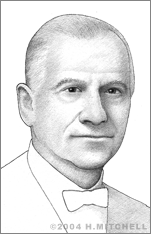John Miller
The inventor sometimes referred to as the “Thomas Edison of the roller coaster” was John A. Miller, who earned more than 100 patents related to coaster technology and ride safety.
Born in August of 1872 in Homewood, Illinois by the name of John Mueller, Miller, who used this name as his professional moniker, embarked on a career that spanned nearly 50 years in 1893. When he was just 19 years old, he began working with a roller coaster designer and engineer by the name of LaMarcus Thompson. Thompson is generally credited with having created the United States’ first roller coaster in Coney Island, New York in 1884 (he patented his “Roller Coasting Structure” in 1885). Before long, Miller was Thompson’s chief engineer.
In 1911, Miller was a consultant for the Philadelphia Toboggan Company, for whom he designed at least a dozen roller coasters. He later worked with Josiah and Fred Pearce on coasters, as well as with Frederick Ingersoll and the Dayton Fun House and Riding Device Manufacturing Company, which became the National Amusement Device Corporation.
In 1920, Miller and Harry C. Baker created a joint company called Miller and Baker, Inc. Through this enterprise, Miller created a mind-boggling number of coasters in a very short amount of time. In 1920 alone, he built at least 15 coasters in cities across the United States. The men broke off their partnership in 1923 when Miller established a business of his own.
Miller constantly pushed the envelope when it came to roller coaster thrills and technology. He insisted that drops could be higher and steeper, turns could be sharper, and the cars could be quicker. His inventions included many safety technologies that are still employed in today’s roller coasters. These include his 1910 creation of the “safety chain dog,” or safety ratchet, a device that prevented coaster cars from rolling backward down the lift hill if the pull chain broke. This device attached to the track and clicked tightly into the chain rungs. This mechanism later evolved into the hardware that produces wooden coasters’ trademark “clickety-clackety” sound.
Another significant achievement was Miller’s 1919 invention of “underfriction wheels,” or “upstop wheels,” which keep coaster cars locked to their tracks. This is critical for allowing the cars to reach high speeds, turn at sharp angles, and go upside down safely, even in rapid succession. These are still found on nearly all of the roller coasters running today.
Miller also developed a variety of braking mechanisms, car bar locks, and various unique custom coaster cars and tracks with whimsical names such as “The Dip-Lo-Docus” and “The Flying Turns” coaster (created in partnership with Norman Bartlett), which had a car that sped through a U-shaped, half-tunnel type of trough. The first ride of this kind was installed at Lakeside Park in Dayton, Ohio in 1929.
He designed coasters for amusement parks all over the U.S. and the world, including the “Wild One” at Six Flags America in Largo, Maryland, the Revere Beach (Mass.) “Thunderbolt,” the "Cyclone" at Puritas Springs in Cleveland, Ohio (named on the Smithsonian Institution's list of Great Lost Roller Coasters), the "Big Dipper" at Blackpool Pleasure Beach in England, and the Roller Coaster at the Western Washington Fair in Washington state. Today, only a few of his coasters are in operation, including “The Racer” coaster at Kennywood Park near Pittsburgh, Pennsylvania.
Miller never stopped building coasters. He traveled extensively to supervise site installations and consult on roller coaster design, even during the final years of his life. He died while working on a coaster project in Houston, Texas on June 24, 1941.
Since then, contemporary coaster companies, such as Custom Coasters Inc. or Great Coasters International, have come to the forefront, but much of the technology that Miller introduced remains standard. Anyone who has ridden a roller coaster is likely to have experienced the benefits of Miller’s work and innovations.


